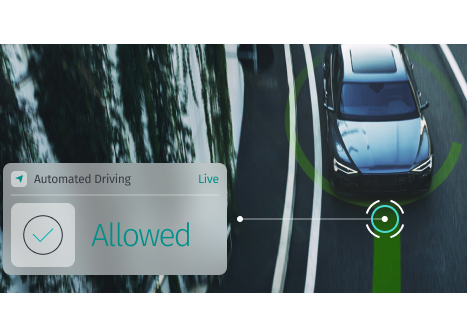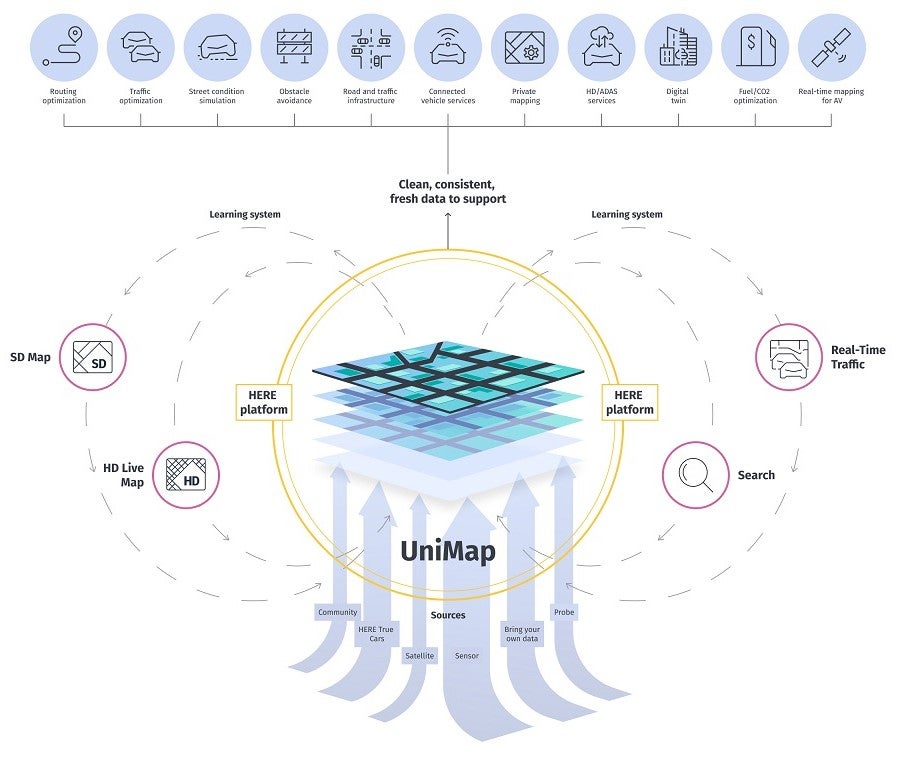
HERE Technologies, the world’s #1 location platform, recently launched UniMap, a revolutionary, highly automated mapping technology which gives developers the power to rapidly create customised digital maps and location products.
First unveiled at CES in Las Vegas earlier this year, UniMap builds on more than three years’ worth of development between HERE Technologies and their customers to deliver unmatched levels of map freshness, quality, and coverage. Using HERE’s mapping sources and big data, UniMap uses AI models to process more than 500 million kilometres of vehicle probe and sensor data every hour, including road signs and speed limits.
This comes at a time when machine learning and AI technologies are beginning to show their real worth. HERE has been using AI for many years to process vast amounts of data from thousands of various sources, from in-vehicle sensors to satellites, as traditional data-processing application software is inadequate to deal with this amount of data in its entirety.
These maps, updated in near real-time, are essential as the world moves towards a more automated driving model. GlobalData reports that the SAE levels of automated driving will continue to advance with fully automated (SAE L5) vehicles predicted to arrive around 2035. HERE already provides map data for millions of vehicles for Advanced Driver Assistance Systems (ADAS) and highly automated driving (SAE L3) use-cases. UniMap will allow automakers to take their automated vehicle programs to the next level using AI generated geospatial data.
Using Machine Learning and AI Map Generators to update Geospatial Data in real-time
While UniMap’s refresh rate works within 24 hours over a global scale, at the local level, those refresh rates are in real-time. Steven Harding, Director of Global Product Management at HERE Technologies notes: “There are features that need to be updated in minutes or seconds for specific use cases.”
Level 2+ piloted driving for instance, where drivers can take their hands off the wheel in certain situations. As automated driving becomes more commonplace, UniMap will come into its own, with elements such as traffic incidents or dynamic speed limits refreshed in minutes or seconds direct to the vehicle.
HERE is leveraging thousands of data sources to ensure that its maps are accurate, and while most of those sources are public, many are private such as vehicle sensor data. To ensure privacy, HERE uniquely anonymises data in a way that means no individual traces can be identified. But collecting data is only part of the process. All that data needs to be collated, sorted, and rationalised, before incorporating into HERE’s unique map object model (MOM) and of course, that data needs to be quality checked and verified.

“We run thousands of validations at varying levels of criticality to ensure quality of the data,” explains Harding. “Every feature in this database and in these products has a freshness, a quality threshold. If it does not meet our defined level, then it won’t get included.” While the automated processes are fast, there is still room for any necessary human intervention that may be required for quality.
“We have been using AI for some time now in terms of how we understand changes in the real world, and those algorithms are further reinforced by the amount of data we collect,” says Harding. “We detect what’s changing in the physical world, whether it’s understanding the direction of vehicle travel or construction closures or lanes being closed. All these things are possible with the models we currently have, and we are expanding on those as we go forward.”
This includes more detailed lane level information, suitable for L2+ driving systems, and predictive technology, building towards truly automated vehicles (L3+). For instance, if you are driving autonomously, you need to know exactly what is around the corner, or over the next hill.
Customers can make their own maps with the UniMap AI Map Generator
One of the most powerful features of UniMap is the ability to develop customised maps. As UniMap powers the overall stack, the end developer can build their own software application, creating content through HERE’s software development kit (SDK). Available to all customers, including automotive companies, desired layers can be selected to create a new system, customised to the customer’s requirements.
This ability to be selective enables the maps to become ‘lighter’ and more responsive for that particular need. For example, in transport logistics or fleet management, you may be interested in truck-specific geospatial data, such as height or weight restrictions on certain roads. Automotive companies may be more focused on vehicle regulations that apply to passenger vehicles.
Harding says that HERE is doing a lot of the up-front work for developers: “This allows for modularity which ties into the software-defined vehicle, decoupling hardware, and software. The map is already separated into defined layers that support the use cases that the vehicle is looking for. For instance, an ADAS application, Intelligent Speed Assistance (ISA), or features that support the high-definition lane model. Previously, these capabilities were delivered through different pipelines and formats, but now it is already aligned, semantically consistent and ready for production.”

This agility UniMap brings to HERE’s customer base is key to the future, suggests Harding. By removing friction from the system, developers can integrate HERE data into their solutions, powering fast, accurate mapping. This is something unique to HERE, in terms of location intelligence and automated mapping.
Harding says that engagement is beneficial and collaboration with major customers, such as BMW, shows the value of such engagements, with customers directly benefiting from the features UniMap brings to their systems: speed, freshness, and cohesiveness. “I would characterise UniMap as the system that ultimately will power our ability to synthesise massive amounts of data and publish it in a manner that’s almost instantly consumable to systems downstream,” he says.
For more information on HERE Technologies’ UniMap, download the paper below.


